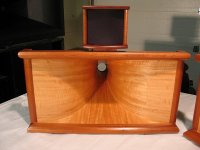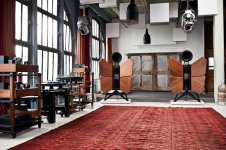is the 632hx the cut off for this multicell so I should crossover higher, say 750hz?
No, I just SWAG'd what the lowest practical XO point might be based on its size Vs a smaller and larger multi-cell I'm familiar with.
Without specific dims including the throat adapter, no way to calculate the absolute lowest, but for sure it should handle a 750 Hz XO/2nd order.
GM
Just to clarify, do you mean small end or the large end of the cells are not as sharp?
The throats [small end]. The WE/Lansing/Altec multi-cell throats I've seen were honed to a near knife edge, something not practical to do with wood unless it's very hard, which of course might crack over time, so not practical.
GM
I think I'll see if the guy can make a pair but get the joint between throat terminations thinner.
Will the increased throat size then become an issue?
Will the increased throat size then become an issue?
which can be negated if he sands the outside of the throat rather then the inside - man my brain is slow to spot the obvious sometimes 🙄
build a skeleton and clamp thin ply in multiple layers to it....or have a giant steam box and put normal play in and then bend it. I believe he used a circular rasp or sandpaper on a stick to shape the throat. JMLC says the throat is the most important part in terms o distortion caused by reflections.
Wow thats some construction there buzzforb. Maybe with the wacky board Charles Darwin just linked to, the hardest part (bending the wood) could be easy?
Also thinking of trying to make a multicell.........
Also thinking of trying to make a multicell.........
Multicells are tough for one reason. Joints. To do that number of joints correctly, with a good fit, is extremely difficult at the very least. It would take a lot of planning and a lot of precision in execution, and you still may have major trouble.In a situation like that, any mistake starts to compound on you.
If using flexible ply, you would have to make sure to have a good skeletalsupport structure, as it does not have the rigidity of standard 1/4 ply or even luan.
If using flexible ply, you would have to make sure to have a good skeletalsupport structure, as it does not have the rigidity of standard 1/4 ply or even luan.
I had in mind cnc cut panels x 4 per cell. Have top & bottom wider so the sides butt up to them. Then spend the rest of my life glueing them all together.
If metal I guess silver solder could work as long as you have a former inside so the panels don't deform under heat
How where the Altec multicells made?
If metal I guess silver solder could work as long as you have a former inside so the panels don't deform under heat
How where the Altec multicells made?
If I were building a multicell from scratch, I'd use thin card or thick paper. Easy to cut, bend and glue. Once built, cover the outside of the cells with whatever damping you choose.
I've made paper-maché horns before and they were wonderful. The base layer was very heavy water color paper. 100% cotton.
I've made paper-maché horns before and they were wonderful. The base layer was very heavy water color paper. 100% cotton.
PAno, Can you think of anything they could be dipped in that would make them stiffer and stronger? Close in thopen areas between the cells and let them fill with same product and you could kill resonances at the same time.
High melt point wax should do nicely. Shootz, you could probably spray the backs with truck bed liner. It works well on speaker baffles. Foam might work, but I'm not sure.
Patience Grasshopper.To do that number of joints correctly, with a good fit, is extremely difficult at the very least.
Not necessary.make sure to have a good skeletalsupport structure
CNC yes, but they must be made all the same. Then as you have seen Petter Persson do, you use different sized rings as clamps and slide them down until snug. Brilliant idea.I had in mind cnc cut panels x 4 per cell. Have top & bottom wider so the sides butt up to them. Then spend the rest of my life glueing them all together.
By hand with the fumes going right up their noses and no sign of any breathing protection.How where the Altec multicells made?
Oh you mean construction? Easy, the top and bottom panels on each segment had flanges that wrapped around the sides so they could be easily aligned and soldered.
Great idea.If I were building a multicell from scratch, I'd use thin card or thick paper. Easy to cut, bend and glue. Once built, cover the outside of the cells with whatever damping you choose.
Big smile for Pano. I love inventive people.I've made paper-maché horns before and they were wonderful. The base layer was very heavy water color paper. 100% cotton.
Once you figure out something to initially stiffen them you can carefully fill in the gaps with expanding foam, slice off the excess and coat it with the finish of your choice.PAno, Can you think of anything they could be dipped in that would make them stiffer and stronger? Close in thopen areas between the cells and let them fill with same product and you could kill resonances at the same time.
paper/card multicells? that I can do 'from the kitchen table' 😎 I guess the curves in the cell walls will add a certain level of instant stability? strips of paper soaked in wallpaper paste draped over the joins then another layer running in the opposite direction.
Any nifty pages for paper multicells Pano?
I found this on tractrix etc DIY Paper Horn the only downside is you have to make a perfect mould....
I was looking at carbon fibre this morning for multicells.....
Any nifty pages for paper multicells Pano?
I found this on tractrix etc DIY Paper Horn the only downside is you have to make a perfect mould....
I was looking at carbon fibre this morning for multicells.....
CNC yes, but they must be made all the same. Then as you have seen Petter Persson do, you use different sized rings as clamps and slide them down until snug. Brilliant idea.
That was a great idea. Its SUCH a shame he hosted his images rather than posting them 🙁 his PM box is full and he hasn't posted for a while....
By hand with the fumes going right up their noses and no sign of any breathing protection.
Oh you mean construction? Easy, the top and bottom panels on each segment had flanges that wrapped around the sides so they could be easily aligned and soldered
Ah the good old days, before common sense was replaced by health and safety and you could inhale anything without it harming you 😀
Simple ideas are the best! bent the excess over the other sides and solder - hey presto ALTECS!!!
Carbon fiber?? How deep are your pockets? Nahhh, just use cellulose fiber, it's got carbon in it. 🙂
Never seen paper multi-cells, but that's how I'd build if they did not need to be super sturdy like pro horns that are made of metal. I used all expensive water color paper on my horns because we had plenty of scraps at work. I also used wallpaper paste and tape. Tedious does not begin to describe it, but I was building up layer after layer. I don't think you'd need to do the mashed up paper thing, just build the shapes then use an easy back coat for damping.
You'll have enough work with all the parts.
Never seen paper multi-cells, but that's how I'd build if they did not need to be super sturdy like pro horns that are made of metal. I used all expensive water color paper on my horns because we had plenty of scraps at work. I also used wallpaper paste and tape. Tedious does not begin to describe it, but I was building up layer after layer. I don't think you'd need to do the mashed up paper thing, just build the shapes then use an easy back coat for damping.
You'll have enough work with all the parts.
- Status
- Not open for further replies.
- Home
- Loudspeakers
- Multi-Way
- And Now For Something REALLY BIG

